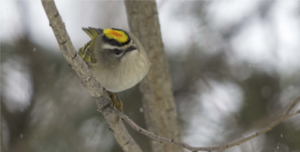After particularly cold nights in the Vermont hills, mornings can be noisy. Trees creak and snap as the first sunlight reflects off of the bright snow and starts to melt ice particles. Occasional wind gusts nudge branches at the tops of trees into motion, dropping a bit of snow near the top, which upsets the next snowy branch below, escalating step by step into an avalanche of powder thundering down out of the pines onto the ground. And amongst the pops and wheezes of the frigid morning, incredibly, come tiny, high-pitched “Tsee tsee tsee” calls from the tops of fir trees.

Golden-Crowned Kinglet
(Regulus Satrapa)
Despite being only slightly larger than a humming bird, golden-crowned kinglets live in the Vermont mountains year-round, feeding on seeds and insects. The work of surviving cold nights in sub-zero temperatures requires of them the same energy output levels of a human running a full marathon every single night. They are so small, constantly losing so much body heat, that any normal survival measure would predict that they would freeze solid within minutes of being placed in the mountains on these coldest nights. And yet, they flourish.
There are two major secrets to their resilience. The first lies in themselves. They cannot warm up their environment, put on winter hats (though the imagined image is adorable), or stoke up the stove. Since they cannot change what is outside of themselves, they must change what is inside. On the coldest nights, they change their behaviors, shivering and slowing their hearts and their body temperature, requiring less fuel to survive. They take deep breaths and endure, waiting for the right time to shift their perspective and get active enough to feed.
 The second secret to their survival is their family groups. Kinglets crowd together on cold nights, huddling for warmth in a line along a slender branch. When the two on the outside start to get too cold, they call out and fly to the middle as other tiny birds make room by shifting outward. They rely on each other, leaning on each other and cyclically watching over one another to make sure they can all work together to survive another difficult night.
The second secret to their survival is their family groups. Kinglets crowd together on cold nights, huddling for warmth in a line along a slender branch. When the two on the outside start to get too cold, they call out and fly to the middle as other tiny birds make room by shifting outward. They rely on each other, leaning on each other and cyclically watching over one another to make sure they can all work together to survive another difficult night.
As temperatures drop at True North during this time of year, our students learn to live like the Kinglets. While they have the comforts of many layers of thick winter clothes, arctic sleeping bags, large fires, and warm shelters with wood stoves, they do not have control over their surroundings. Snowflakes float on the wind and accumulate in drifts, temperatures drop, and the wind blows regardless of disagreement or manipulation by any human being. Instead, like the kinglets, our students turn inward, looking at their own perspectives and abilities reflected back by the cold outside. They shift their understanding of their individual place in the world around them and change their behaviors, beginning to recognize their own inherent strength and sense of resilience as they realize, often to their own surprise, “I can make it through this.”
And, like the kinglets, they rely on those around them. They learn to function as a team, leaning on each member’s strongest skills as they stack wood, cook warm meals over open fires, and hold reflection circles together. They listen to each other’s feedback and suggestions, seeking advice and support delivered visibly through clouds of breath. Despite the cold air’s pervasive attempts to freeze the individual, the group moves forward, their laughter echoing through the trees, mixed with blowing winds and the kinglets’ cheerful calls above. Upon this cold landscape that so many would callously regard as desolate and dangerous, we see that life, warmth, and connection continue to grow.


